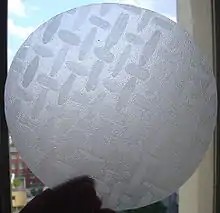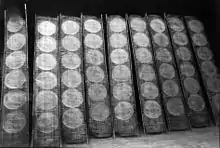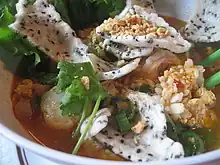 A bánh tráng wrapper | |
| Type | Edible wrapper |
|---|---|
| Place of origin | Vietnam |
| Region or state | Southeast Asia |
| Main ingredients | Rice flour or tapioca starch (or both), and various ingredients, including spices |
| Variations | Thin, soft to thick, depending on the type of banh trang |
Bánh tráng or bánh đa nem, a Vietnamese term (literally, coated bánh), sometimes called rice paper wrappers, rice crepes, rice wafers or nem wrappers, are edible Vietnamese wrappers used in Vietnamese cuisine, primarily in finger foods and appetizers such as Vietnamese nem dishes. The term rice paper wrappers can sometimes be a misnomer, as some banh trang wrappers are made from rice flour supplemented with tapioca flour or sometimes replaced completely with tapioca starch.[1][2] The roasted version is bánh tráng nướng.[3]
Description

Vietnamese banh trang are rice paper wrappers that are edible.[1] They are made from steamed rice batter, then sun-dried. A more modern method is to use machines that can steam and dry the wrapper for a thinner and more hygienic product, suitable for the export market.
Types
Vietnamese banh trang wrappers come in various textures, shapes and types. Textures may vary from thin, soft to thick (much like a rice cracker). Banh trang wrappers come in various shapes, though circular and squared shapes are most commonly used. A plethora of local Vietnamese ingredients and spices are added to Vietnamese banh trang wrappers for the purpose of creating different flavors and textures, such as sesame seeds, chili, coconut milk, bananas, and durian, to name a few.
Bánh tráng
Southern Vietnamese term for rice wrappers, which are also commonly used overseas. These banh trang wrappers are made from a mixture of rice flour with tapioca starch, water and salt.[4] These wrappers are thin and light in texture. They are often used for chả giò and gỏi cuốn. There are also certain rice wrappers products that are specifically for frying.
Bánh đa nướng / Bánh tráng nướng (grilled rice cracker)
Bánh đa nướng or bánh tráng nướng are roasted or grilled rice crackers. Some can be thicker than the standard rice wrapper and can also include sesame seeds. It is often used in dishes like Mì Quảng as a topping. Not be confused with the street food dish from Đà Lạt (also known as Vietnamese pizza or quesadilla) with the same name.
Bánh đa nem (vỏ ram / bánh ram)
This is a northern Vietnamese term for rice paper. There is a special variety that contains only rice flour and no tapioca starch, water and salt. Brown bánh đa nem may contain cane syrup (mật mía). These wrappers are very thin and translucent. They also do not require to be soaked with water before usage. When fried, they are crispier and not as chewy like its southern counterpart. It is used as a wrapper when making nem cua bể.
Bánh tráng rế (Woven banh trang)
These banh trang wrappers are made from rice flour, green beans, vegetable oil and salt.[5] These wrappers are delicate and thin. They are lacy, net-like wrappers typically used for deep-fried cha gio rolls.[6]
Bánh tráng mè (Sesame banh trang)
These banh trang wrappers are typically made from rice starch, then adding sesame seeds. Its texture resembles that of a rice cracker.
Bánh tráng tôm mè (Sesame-shrimp banh trang)
These banh trang wrappers are made by adding sesame seeds and dried shrimps. Its texture resembles that of a rice cracker.
Bánh tráng sữa (Milky banh trang)
Bánh tráng sữa are made by adding milk. This type of banh trang is softer, and supposed to melt on your tongue.
Bánh tráng dẻo
Bánh tráng dẻo are soft and malleable sheets. They also come in different flavors.
Bánh tráng mỏng (thin bánh tráng)
Thin sheets made from only tapioca starch. They are dried and translucent and are more sticky when activated with water.
Bánh tráng chuối (Banana flavored banh trang)
These banh trang wrappers are typically made by adding bananas. Its texture resembles that of a rice cracker.
Bánh tráng dừa (Coconut flavored banh trang)
These banh trang wrappers are typically made by adding coconut milk, sugar, rice flour, sesame seeds, and water. The texture resembles that of a cracker, similar to the sesame banh trang.
Bánh tráng phơi sương
Bánh tráng phơi sương are wrappers with flexible two layered rice paper.
Bánh tráng trộn (Mixed rice paper)
Mixed rice paper has the main ingredient is rice paper cut yarn, mixed with fried dried shrimp with fat.
Culinary uses

Banh trang wrappers are typically used in Vietnamese nem dishes. These wrappers are eaten dried (khô), fried (rán), baked (nướng) or soaked (ướt). They are typically served rolled (cuộn) or baked (nướng), in salads, soups and stirred fried Vietnamese dishes.
The light, translucent traditional banh trang wrappers are typically used for various Vietnamese rolls, more commonly the goi cuon (salad rolls).[7] Though commonly used in fresh rolls, Northern Vietnamese cuisine often use these wrappers in chả giò (Northern Vietnamese: Nem rán), a crispy, fried springroll.[8] Traditional banh trang wrappers are also used to wrap common Vietnamese dishes such as banh xeo (Vietnamese sizzling pancakes), bò 7 món (Vietnamese seven courses of beef) and cá nướng (Vietnamese grilled fish) and then dipped into a sauce.
The traditional banh trang wrappers are also used to make a Vietnamese salad dish called bánh tráng trộn (stirred banh trang salad).[9]
Woven banh trang wrappers are typically deep-fried to make aesthetically appealing cha gio (Vietnamese crispy spring rolls).
Sesame banh trang wrappers are typically baked or soaked in water, depending on individual textural preference, then served with salads, mi Quang and various other dishes.
Outside Vietnam
Banh trang wrappers are found in countries outside Vietnam with Vietnamese diaspora.
References
- 1 2 "Twice as rice: there is rice paper, and then there is rice paper. - Free Online Library". Thefreelibrary.com. Archived from the original on 2015-06-10. Retrieved 2013-10-06.
- ↑ Lucy Nguyen-Hong-Nhiem - A Dragon Child: Reflections Of A Daughter Of Annam In America - 2004 p13 "The batter is made of rice flour, which my mother would prepare herself. The night before she would soak the rice. Early in the morning, she would take it to the neighbors (who specialized in making rice paper called bánh tráng) to use in their ..."
- ↑ Phillip Taylor, Modernity and Re-Enchantment: Religion in Post-Revolutionary Vietnam Institute of Southeast Asian Studies - 2007 p 145 "... along with personal bowls, spoons, chopsticks, paper napkins, saucers of fish-sauce dip and bottles of beer and soft drinks. ... and onion, seasoned with lime, sugar and fish sauce, served with a large roasted rice cracker [bánh tráng nướng].
- ↑ "Banh Trang Recipes". Pham Fatale. Archived from the original on 2013-10-16. Retrieved 2013-10-06.
- ↑ "Re Rice Paper" (in Vietnamese). Huongvietfood.vn. Archived from the original on 2015-03-17. Retrieved 2013-10-06.
- ↑ "Saigon Food Souvenirs - Viet World Kitchen". Vietworldkitchen.typepad.com. 2008-05-14. Archived from the original on 2013-05-31. Retrieved 2013-10-06.
- ↑ "Goi Cuon with Peanut Hoisin Dipping Sauce". Sunday Nite Dinner. 2008-02-13. Archived from the original on 2013-12-07. Retrieved 2013-10-06.
- ↑ "Cha Gio / Nem Ran / Vietnamese Fried Rolls | Giant Hippo Cha Gio / Nem Ran / Vietnamese Fried Rolls | Home of the (Gluten- & Allergen-)Free!". Gianthippo.org. 2012-08-01. Archived from the original on 2013-11-04. Retrieved 2013-10-06.
- ↑ "Brightclouds - Xử lý bánh tráng còn dư - Bánh tráng trộn". My.opera.com. 2011-06-17. Archived from the original on 2012-06-06. Retrieved 2013-10-06.